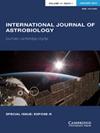Self-conscious intelligent technological societies in the universe: a simple direct approach to probable astrosociological realistic scenarios
IF 1
4区 物理与天体物理
Q3 ASTRONOMY & ASTROPHYSICS
引用次数: 0
Abstract
We present an alternative equation to estimate the probable number N of self-conscious intelligent technological societies (SCITSs) within the radius of the observable universe. This equation has only one poorly-known factor, Pc, the SCITS's formation probability, which can be estimated within an uncertainty by a factor of 102 (10−11 ≤ Pc ≤ 10−9) by applying the restriction imposed by Fermi's Paradox. The SCITS's formation rate for a typical spiral galaxy is then estimated as ≈1 civ Gyr−1. For a very optimistic maximum life expectancy ≈108 yr, the conclusion is that two civilizations never coexist in the same galaxy. Our estimated values for Pc are compatible with current biological and astrophysical evidences. We also propose an alternative astrosociological classification scheme which enables us to speculate about possible evolutionary paths for SCITSs in the universe. The so-called ‘Closed Bottle Neck’ (CBN) scenario suggests that civilizations are no exit evolutionary ways. We argue that simply there would not be interstellar travels nor Galaxy colonization or a Galactic Club. Thus Fermi's Paradox results eliminated, and the perspectives about the future of our own civilization may not be positive.宇宙中有自我意识的智能技术社会:对可能的天体社会学现实场景的简单直接方法
我们提出了一个替代方程来估计可观测宇宙半径内自我意识智能技术社会(SCITS)的可能数量N。该方程只有一个鲜为人知的因子Pc,即SCITS的形成概率,通过应用费米悖论施加的限制,可以在不确定度为102的因子(10−11≤Pc≤10−9)的范围内估计。对于一个典型的螺旋星系,SCITS的形成速率被估计为≈1 civ Gyr−1。对于一个非常乐观的最大预期寿命≈108年,结论是两个文明永远不会共存于同一个星系。我们对Pc的估计值与当前的生物学和天体物理学证据相一致。我们还提出了一种替代的天体社会学分类方案,使我们能够推测宇宙中SCITS的可能进化路径。所谓的“封闭的瓶颈”(CBN)场景表明,文明是无法退出的进化方式。我们认为,根本不会有星际旅行,也不会有银河殖民或银河俱乐部。因此,费米悖论的结果被消除了,关于我们自己文明未来的观点可能不是积极的。
本文章由计算机程序翻译,如有差异,请以英文原文为准。
求助全文
约1分钟内获得全文
求助全文
来源期刊

International Journal of Astrobiology
地学天文-地球科学综合
CiteScore
3.70
自引率
11.80%
发文量
45
审稿时长
>12 weeks
期刊介绍:
International Journal of Astrobiology is the peer-reviewed forum for practitioners in this exciting interdisciplinary field. Coverage includes cosmic prebiotic chemistry, planetary evolution, the search for planetary systems and habitable zones, extremophile biology and experimental simulation of extraterrestrial environments, Mars as an abode of life, life detection in our solar system and beyond, the search for extraterrestrial intelligence, the history of the science of astrobiology, as well as societal and educational aspects of astrobiology. Occasionally an issue of the journal is devoted to the keynote plenary research papers from an international meeting. A notable feature of the journal is the global distribution of its authors.
 求助内容:
求助内容: 应助结果提醒方式:
应助结果提醒方式:


